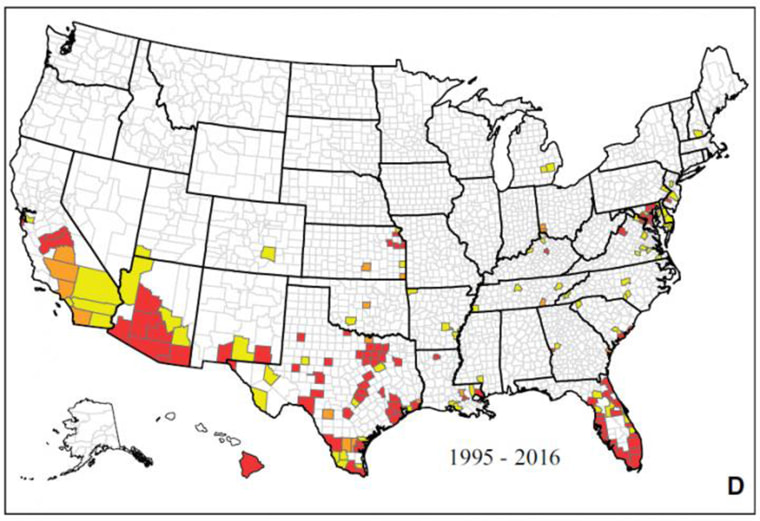A new map shows mosquitoes that can carry the Zika virus are found in 40 states and Washington, D.C.

Public health officials are bracing for local outbreaks of the Zika virus in the continental U.S. as mosquito season gets under way. Thousands of travelers from Latin America and the Caribbean have already come back infected — hundreds of those cases have been documented — and if a mosquito bites someone with an active infection, it could potentially carry the virus to someone else.
The map, compiled by experts at the Centers for Disease Control and Prevention, looks at all reports of the two species of mosquito that can transmit the virus: Aedes aegypti, also known as the yellow fever mosquito, and Aedes albopictus, or the Asian tiger mosquito.
“Between January 1995 and March 2016, 183 counties from 26 states and the District of Columbia reported the occurrence of Aedes aegypti, and 1,241 counties from 40 states and the District of Columbia reported the occurrence of Aedes albopictus,” the CDC’s Micah Hahn and colleagues wrote in the Journal of Medical Entomology.
"Our findings underscore the need for systematic surveillance of Ae. aegypti and Ae. albopictus in the United States and delineate areas with risk for the transmission of these introduced arboviruses.”
The team used records from CDC’s mosquito-borne disease database, mosquito control agencies, university researchers and state and local health departments.
Of most concern is Aedes aegypti, a tropical mosquito that carries not only Zika, but yellow fever, dengue and chikungunya. It thrives in urban areas and lives close to people.
“Since 1995, Ae. aegypti has been documented along much of the southern tier of the United States, including southern California, Arizona, New Mexico, Texas, Louisiana, and Florida,” Hahn’s team wrote.
“There also have been sporadic collections of Ae. aegypti from other parts of the Southeast and the Mid-Atlantic states, as well as in geographic outliers in Colorado, Kansas, Michigan, and New Hampshire.”
In the past 10 years epidemics of dengue and chikungunya have swept through Latin America and the Caribbean. Dengue’s also been seen in Hawaii. Now Zika’s doing the same thing, and has also hit the U.S. territories of Puerto Rico and the U.S. Virgin Islands.
“Yellow fever virus remains a concern with sporadic yellow fever outbreaks in South America,” Hahn’s team added.
With 40 million travelers going back and forth from the U.S. to Zika-affected regions every year, it’s inevitable that some will come back infected. The CDC has documented 618 Zika cases in the continental U.S. and experts say thousands more are almost certain to have gone unreported. The CDC knows of 195 pregnant women with Zika in the continental U.S. and 146 in U.S. territories.
The report notes that the U.S. has tried but failed to wipe out the yellow fever mosquito. “The program to eradicate Ae. aegypti from the continental United States never reached its ultimate goal and was terminated in 1969 due to lack of funds,” it says.
Bites during the day
State and local public health officials say they still lack the funds needed to get ready for Zika, look for the mosquitoes and eradicate them. President Barack Obama asked Congress for $1.9 billion to do this and more. The House and Senate are considering separate bills that would provide some of the money
“Aedes aegyptimost likely has been present, permanently or intermittently, in the southeastern United States since the 17th century and is the suspected vector of the yellow fever and dengue outbreaks that occurred in the eastern part of the country from 1650 to the early 20th century,” the team noted.
And after arriving in Texas in 1985, Aedes albopictus spread across much of the country. It’s much more tolerant of cold temperatures, bites during the day and thrives more in the suburbs than in the cities.
“Ae. albopictus has been consistently reported from most of the Southeast, South Central, and Mid-Atlantic states as well as along the southern Ohio River Valley. Reports for Ae. albopictus are more sporadic in the western United States than Ae. aegypti, but there have been consistent reports of the mosquito from southern California and southwestern Arizona,” the report reads.
RELATED:
